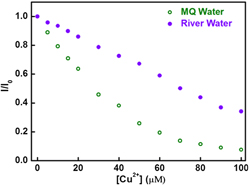Crossref Citations
This article has been cited by the following publications. This list is generated based on data provided by
Crossref.
Lu, Qian
Zhang, Yuanjian
and
Liu, Songqin
2015.
Graphene quantum dots enhanced photocatalytic activity of zinc porphyrin toward the degradation of methylene blue under visible-light irradiation.
Journal of Materials Chemistry A,
Vol. 3,
Issue. 16,
p.
8552.
Benítez-Martínez, S.
and
Valcárcel, M.
2015.
Graphene quantum dots in analytical science.
TrAC Trends in Analytical Chemistry,
Vol. 72,
Issue. ,
p.
93.
Saleem, Muhammad
and
Lee, Ki Hwan
2015.
Optical sensor: a promising strategy for environmental and biomedical monitoring of ionic species.
RSC Advances,
Vol. 5,
Issue. 88,
p.
72150.
Benítez-Martínez, S.
Caballero-Díaz, E.
and
Valcárcel, M.
2016.
Development of a biosensing system for tacrine based on nitrogen-doped graphene quantum dots and acetylcholinesterase.
The Analyst,
Vol. 141,
Issue. 9,
p.
2688.
Protich, Z.
Santhanam, K. S. V.
Jaikumar, A.
Kandlikar, S. G.
and
Wong, P.
2016.
Electrochemical Deposition of Copper in Graphene Quantum Dot Bath: Pool Boiling Enhancement.
Journal of The Electrochemical Society,
Vol. 163,
Issue. 6,
p.
E166.
Protich, Z.
Wong, P.
and
Santhanam, K. S. V.
2016.
Composite of Zinc Using Graphene Quantum Dot Bath: A Prospective Material For Energy Storage.
ACS Sustainable Chemistry & Engineering,
Vol. 4,
Issue. 11,
p.
6177.
Sinduja, Bharathi
and
John, S. Abraham
2016.
Sensitive determination of tannic acid using blue luminescent graphene quantum dots as fluorophore.
RSC Advances,
Vol. 6,
Issue. 65,
p.
59900.
López‐Lorente, Ángela I.
2016.
Encyclopedia of Analytical Chemistry.
p.
1.
Protich, Z.
Wong, P.
and
Santhanam, K.S.V.
2016.
A new graphene composite with a high coulombic efficiency.
Journal of Power Sources,
Vol. 332,
Issue. ,
p.
337.
Yang, Tao
Zhu, Fang
Zhou, Tianxiao
Cao, Jianzhong
Xie, Yibo
Zhang, Meiyi
Wang, Yan
Cao, Dong-Sheng
Lin, Qinlu
and
Zhang, Lin
2017.
Label-free, Water-soluble Fluorescent Peptide Probe for a Sensitive and Selective Determination of Copper Ions.
Analytical Sciences,
Vol. 33,
Issue. 2,
p.
191.
Patra, Santanu
Roy, Ekta
Tiwari, Ashutosh
Madhuri, Rashmi
and
Sharma, Prashant K.
2017.
2-Dimensional graphene as a route for emergence of additional dimension nanomaterials.
Biosensors and Bioelectronics,
Vol. 89,
Issue. ,
p.
8.
Kim, Tae-Hyung
Lee, Donghyun
and
Choi, Jeong-Woo
2017.
Live cell biosensing platforms using graphene-based hybrid nanomaterials.
Biosensors and Bioelectronics,
Vol. 94,
Issue. ,
p.
485.
Fu, Xu-Cheng
Jin, Jiang-Zhou
Wu, Ju
Jin, Jun-Cheng
and
Xie, Cheng-Gen
2017.
A novel turn-on fluorescent sensor for highly selective detection of Al(iii) in an aqueous solution based on simple electrochemically synthesized carbon dots.
Analytical Methods,
Vol. 9,
Issue. 26,
p.
3941.
Shen, Chao
Ge, Shuyan
Pang, Youyou
Xi, Fengna
Liu, Jiyang
Dong, Xiaoping
and
Chen, Peng
2017.
Facile and scalable preparation of highly luminescent N,S co-doped graphene quantum dots and their application for parallel detection of multiple metal ions.
Journal of Materials Chemistry B,
Vol. 5,
Issue. 32,
p.
6593.
Kaur, Manjot
Mehta, Surinder K.
and
Kansal, Sushil Kumar
2017.
Nitrogen doped graphene quantum dots: Efficient fluorescent chemosensor for the selective and sensitive detection of 2,4,6-trinitrophenol.
Sensors and Actuators B: Chemical,
Vol. 245,
Issue. ,
p.
938.
Ciotta, Erica
Paoloni, Stefano
Richetta, Maria
Prosposito, Paolo
Tagliatesta, Pietro
Lorecchio, Chiara
Venditti, Iole
Fratoddi, Ilaria
Casciardi, Stefano
and
Pizzoferrato, Roberto
2017.
Sensitivity to Heavy-Metal Ions of Unfolded Fullerene Quantum Dots.
Sensors,
Vol. 17,
Issue. 11,
p.
2614.
Ciotta, Erica
Prosposito, Paolo
Tagliatesta, Pietro
Lorecchio, Chiara
Stella, Lorenzo
Kaciulis, Saulius
Soltani, Peiman
Placidi, Ernesto
and
Pizzoferrato, Roberto
2018.
Discriminating between Different Heavy Metal Ions with Fullerene-Derived Nanoparticles.
Sensors,
Vol. 18,
Issue. 5,
p.
1496.
Mahto, Madhusudan Kr.
Samanta, Dipanjan
Konar, Suraj
Kalita, Himani
and
Pathak, Amita
2018.
N, S doped carbon dots—Plasmonic Au nanocomposites for visible-light photocatalytic reduction of nitroaromatics.
Journal of Materials Research,
Vol. 33,
Issue. 23,
p.
3906.
Li, Xue
He, Da-Wei
Wang, Yong-Sheng
Hu, Yin
Zhao, Xuan
Fu, Chen
and
Wu, Jing-Yan
2018.
Facile and controllable synthesis of molybdenum disulfide quantum dots for highly sensitive and selective sensing of copper ions.
Chinese Physics B,
Vol. 27,
Issue. 5,
p.
056104.
Mishra, Praveen
and
Bhat, Badekai Ramachandra
2019.
Calcium‐Induced Photoluminescence Quenching of Graphene Quantum Dots in Hard Water: A Quick Turn‐Off Sensing Approach.
ChemistrySelect,
Vol. 4,
Issue. 29,
p.
8682.
